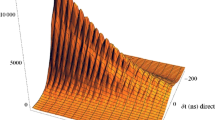Abstract
Overmodulation of electron paramagnetic resonance (EPR) lines is routinely used in EPR oximetry in order to increase the signal-to-noise ratio and thus to improve the accuracy with which the line width of a spin probe can be measured. For a known probe type, the line width is easily translated into the oxygen partial pressure. A standard EPR spectrometer uses the analog phase-sensitive detection (PSD) to demodulate the EPR signal. PSD imposes the restriction that only one spectrum is measured at a time, which is normally the first-harmonic EPR line. Information about EPR signals centered at the other harmonics of the modulation frequency is irreversibly destroyed by PSD. The question is raised whether this information can be utilized for EPR oximetry, for overmodulation enhances the second- and the other harmonic spectra, so that they approach the first-harmonic spectrum in intensity. To find an answer, numerical simulation and experimental measurements have been conducted. The experiment required modification of the detection scheme, so that all EPR-related information in the overmodulated signal is preserved. This permits measuring of the multiharmonic EPR spectrum, which when fitted to a set of the corresponding theoretical lines produces more accurate results in comparison with the standard overmodulation method.






Similar content being viewed by others
References
C.P. Poole, Electron Spin Resonance: A Comprehensive Treatise on Experimental Techniques (Wiley, New York, 1967)
B.H. Robinson, C. Mailer, A.W. Reese, J. Magn. Reson. 138, 199–209 (1999)
C. Mailer, B.H. Robinson, B.W. Benjamin, H.J. Halpern, Magn. Reson. Med. 49, 1175–1180 (2003)
Y. Deng, R.P. Pandian, R. Ahmad, P. Kuppusamy, J.L. Zweier, J. Magn. Reson. 181, 254–261 (2006)
M.P. Tseitlin, V.S. Iyudin, O.A. Tseitlin, Appl. Magn. Reson. 35, 569–580 (2009)
V.O. Grinberg, A.I. Smirnov, O.Y. Grinberg, S.A. Grinberg, J.A. O’Hara, H.M. Swartz, Appl. Magn. Reson. 28, 69–78 (2005)
Acknowledgments
This work was supported by Russian Science Support Foundation grants 06-03-32175, 04-03-97514, by the Program “Leading Scientific Schools” NSh 6213.2006.2, and by the CRDF grant (BRHE program). We thank Dr. Gareth Eaton of the University of Denver for his help in editing our English language usage.
Author information
Authors and Affiliations
Corresponding author
Rights and permissions
About this article
Cite this article
Tseitlin, M.P., Tseitlin, O.A. Using of Digital Demodulation of Multiharmonic Overmodulated EPR Signals to Improve EPR Oximetry Reliability. Appl Magn Reson 36, 25–34 (2009). https://doi.org/10.1007/s00723-009-0009-3
Received:
Published:
Issue Date:
DOI: https://doi.org/10.1007/s00723-009-0009-3



